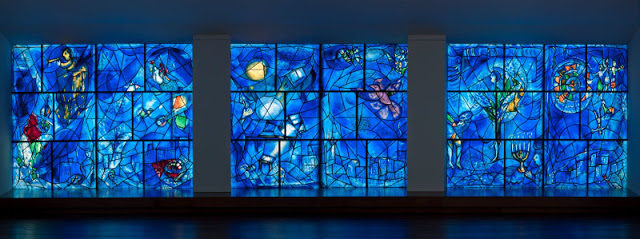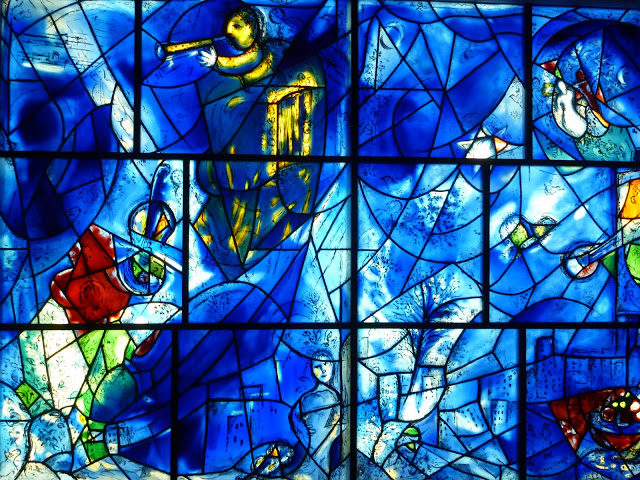America Windows, 1977, By Marc Chagall, Art Institute of Chicago
America Windows-Panel 1
America Windows-Panel 2
America Windows-Panel 3
America Windows, 1977
By Marc Chagall
Stained glass, 96 x 385 in. (244 x 978 cm) (overall)
Signed, each pair, l.r.: “MArc ChAgAll/Reims/1977”
A gift of Marc Chagall, the City of Chicago, and the Auxiliary Board of The Art Institute of Chicago, commemorating the American Bicentennial in memory of Mayor Richard J. Daley.
About the Art
Presented as a gift to the Art Institute of Chicago in 1977, the America Windows remain an integral symbol of the city’s longstanding relationship with the arts. At eight feet high and thirty feet across, these stained glass windows are a vast arrangement of colors of the highest intensity—bright reds, oranges, yellows, and greens—placed against brilliant shades of blue. Representations of people, animals, and items such as writing implements, musical instruments, and artists’ tools float above a skyline of buildings and trees. Artist Marc Chagall began working on his design for the windows in 1976, America’s bicentennial year, and constructed the windows as a tribute to the freedom of artistic expression enjoyed by the people of the United States. When designing the windows, he stated, “When one works, one must have a vision.” For Chagall, that vision was a vibrant celebration of humankind’s creative energy.
The America Windows consist of three main sections, each divided into two panels; together, the six panels feature imagery that honors the arts and America’s independent spirit. While there are many details throughout the windows, particular items in each panel reveal distinct themes. Reading from left to right, the first panel represents music, including images of musicians with violins and horns. A faint detail in the upper left corner suggests part of a musical score with staff and notes. The second panel alludes to painting with depictions of paint brushes, a canvas, an artist’s palette, and, in the lower right corner, bottles and a bowl of food, items that could be part of a still life. In the third panel, books, a desk, an inkwell, and an extended hand holding a pen evoke the
world of literature and expression through the written word. The fourth panel shows a bird flying over a skyline containing the Statue of Liberty, reminding viewers of America’s founding principles of freedom and democracy. (The Statue of Liberty, a gift from the French, celebrated America’s centennial in 1876; the America Windows were Chagall’s gift for the bicentennial.)
The final two panels bring the viewer back to the arts. In the fifth panel, depicting the theater, a curtain surrounds the top of a stage set, framing performers, one of whom is holding a mask, and a candelabrum. The sixth, and last panel represents dance, with a group of performers, some holding tambourines, hovering near a dynamic swirling form of colors and shapes that surround a solitary figure. All six panels of the America Windows, connected by a shared skyline, create a singular scene of creative and personal freedom. Despite the identification of these larger themes of creative and personal freedom, scholars are reluctant to ascribe specific meaning to many of the details in the windows, as they may have simply been personally appealing to Chagall and not particularly
symbolic of anything related to the themes of the six panels.
All of the rich details and images found in the America Windows are portrayed in Marc Chagall’s unique and highly recognizable style. While he acknowledged the influence of the many places, ideas, and people that he encountered over his long life, often sharing and borrowing methods from Cubism, Surrealism, and Fauvism, Chagall never officially aligned himself with any particular artistic movement. His extraordinary use of color, whimsical depiction of figures and animals, playful manipulation of space and scale, and personal lexicon of motifs were all his own. Among the dominant characteristics of his work, the vivid colors of Chagall’s images are often regarded as his signature. Termed a true colorist, the hues that Chagall used impacted the impression of the scene, bringing a note of brightness to even his most somber subjects. He expressed himself and claimed to dream in color, identifying most with the color blue. “I am blue,” he said, “like Rembrandt was brown.” This dictum was never so true as in the America Windows. More here.
About the Artist
Marc Chagall was born in Belarus in 1887 and developed an early interest in art. After studying painting, in 1907 he left Russia for Paris, where he lived in an artist colony on the city’s outskirts. Fusing his own personal, dreamlike imagery with hints of the fauvism and cubism popular in France at the time, Chagall created his most lasting work—including I and the Village (1911)—some of which would be featured in the Salon des Indépendants exhibitions. After returning to Vitebsk for a visit in 1914, the outbreak of WWI trapped Chagall in Russia. He returned to France in 1923 but was forced to flee the country and Nazi persecution during WWII. Finding asylum in the U.S., Chagall became involved in set and costume design before returning to France in 1948. In his later years, he experimented with new art forms and was commissioned to produce numerous large-scale works. Chagall died in St.-Paul-de-Vence in 1985.
Our Sponsors
Our Sponsors this month are Creative Impressions In Clay and BlueHareArtWear.
Please visit us tomorrow to see the prizes!
How to Enter the Monthly Challenge:
1. You need to have a Pinterest account. Go get one ASAP if you don’t have one already. It’s easy, fun and inspiring.
2. Email us at [email protected] to get added to the monthly challenge board.
Subject: Monthly Challenge Board Request
You will be emailed an invite to the board within 48 hours. Accept the invite and you are ready to pin your entries.
3. Two ways to pin your entry to the board.
Pin your photo from the internet (on your blog, Etsy shop, etc.)
Add your photo directly from your computer
Create something using an art bead that fits within our monthly theme. We post the art to be used as your inspiration to create. This challenge is open to jewelry-makers, fiber artists, collage artist, etc. The art bead can be created by you or someone else. The challenge is to inspire those who use art beads and to see all the different ways art beads can be incorporated into your handiwork.
An Art Bead must be used in your piece to qualify for the monthly challenge.
***Beads strung on a chain, by themselves and beads simply added to wire or cord will not be accepted.***
Please add the tag or title DEC ABS to your photos. Include a short description, who created the art beads and a link to your blog, if you have one.
Deadline is December 30th
You may upload 2 entries per month.
ENTRIES for ART BEAD ARTISTS!!
• Beads Makers Pinterest Board-Art beads must be created by you and fit the Art Bead Scene’s monthly challenge theme. They can be made for the challenge or ones you have made before. 2 entries per month are allowed.
One entry will be picked by the editors each month for a free month of advertising on the Art Bead Scene. Bead entries have to be pinned by the 30th of the month.
Beads only – do not post jewelry on this board. If a post doesn’t fit the challenge it will be deleted.
Monthly Challenge Recap
• Please post at least one single shot of your creation on the Pinterest Board. This will be used to make a collage for the Monthly Challenge Gallery. Every creation will be added to the collage, regardless of a blog post. So everyone gets included!
Your entry must be on Pinterest 2 days BEFORE the recap to be included.
• Be sure to share with us the name of the art bead artist in the description of your photo so that if you are selected for the weekly Perfect Pairings on Wednesdays, both you as the designer and the art bead artist can get the credit you both deserve!
• An InLinkz button will be added to the bottom of the Monthly Challenge Recap post. Here you will be able to link up your blog post if you have one. It is no longer necessary to add your blog post URL to the description unless you want to. Be sure to hop around and see all the great inspiration and leave some comment love!
• The Monthly Challenge Recap with Blog Tour will be posted on December 30th.
Monthly Challenge Winners
• One prize winner will be selected at random from all blog posts added to the hop for the Monthly Challenge Recap post. So if you want to be in the pool for the second prize, be sure to use the InLinkz code at the bottom of the post to share your process and inspirations!
• Winners will be randomly chosen from all the qualifying entries on December 1st.
Perfect Pairings :: Designer + Art Bead Artist
• Formerly the Featured Designer of the Week, our new Perfect Pairings will focus on both the jewelry designer and the art bead artist.
• Be sure to point out all the art bead artists in your work in the description of the photo on the Pinterest Board. Links to their website or shop are appreciated. That way we can all find new art beads to love!
• From all the entries during the month, an editor will pick their favorite design to be featured every Wednesday here on ABS, so get those entries in soon.
What is an Art Bead?
An art bead is a bead, charm, button or finding made by an independent artist. Art beads are the vision and handiwork of an individual artist. You can read more about art beads here.
***A bead that is handmade is not necessarily an art bead. Hill Tribe Silver, Kazuri ceramic beads or lampwork beads made in factories are examples of handmade beads that are not considered art beads.
Beaded beads, stamped metal pendants or wire-wrapped components are not considered art beads for our challenge.***




